What is D2C (Direct to Consumer)?
Before we dive into creating a 3D strategy for Direct to Consumer (D2C) brands. Let’s set the foundation for what exactly we’re referring to when we talk about D2C.
Direct to Consumer is a business model that allows businesses to sell directly to customers. These companies do not need traditional marketplaces or stores to market their products. They can reduce costs and maintain complete ownership of their manufactures, commercial operations and distributions. A number of early adopters successfully experimented using the D2C model for eCommerce sales and social media –– effectively cutting out the middleman.
Traditional Retailers vs D2C
When manufacturers send product lines to wholesalers this takes them through various retail stores before reaching the final consumer. D2C models eliminate all the intermediaries. Instead, companies can offer their products directly to their end customers by importing the products directly. So, why don’t all manufacturers go the D2C route? Well, moving from the traditional model to D2C requires extensive time and investment. In addition, there is a lot to consider about the pains retailers experience when it comes to branding and marketing that manufacturers simply pass on. Most manufacturers have enough on their plate that handling creative direction, photography and marketing is the last thing they want to do. But it’s not impossible.
For instance, Interior Define, Rove Concepts, and Article are great examples of furniture manufacturers harnessing the D2C model, and have created recognizable brands with their content.
Get the latest updates straight to your inbox.
By clicking sign up you'll receive occasional emails from imagine.io. You always have the choice to unsubscribe within every email you receive.
The Competitive Advantages Of D2C Brands
Despite the additional work that goes into delivering a D2C brand to consumers, there are a number of benefits to consider.
We’ve identified 7 significant benefits for D2C brands:
Brand control: The traditional manufacturer/retailer relationship provides little room for manufacturers to control their brand image. Ultimately it’s the retailers that present the product to the consumer, and once the product is in the hands of retailers, there's no guarantee that marketing specifications passed down from the manufacturer will influence a sale. With D2C, brands who own their products at every step of the customer journey are able to understand their buyers better and adjust their marketing to influence sales.
Scalability: The D2C model allows manufacturers to launch new products at a smaller scale, test with selected demographics, and collect data. This gives manufacturers the chance to understand what customers want, produce more of what sells, and less of what doesn’t, and improve their product offering. In a non-D2C environment, retailers are forced to limit inventory and stock products that are proven to sell. This restricts manufacturers to produce only what retailers deem worth selling because it’s not worth the cost to test out new products.
Data Collection: The opportunity for manufacturers to collect customer data via direct marketing and advertising reveals greater opportunity to learn about what their consumers really want. Retailers may be missing out on some key consumer trends for products and are not communicating that information to the manufacturers. Through better data collection, manufacturers can optimize existing products, and, possibly, create completely new product lines.
Higher margins: By eliminating the middleman, D2C brands can sell their products at the same price as retailers, which ultimately improves the bottom line. Obviously, no middleman means no markup from cost to gross sale, and with growing supply chain concerns, selling directly has a clear cost advantage.
Brand loyalty: When consumers buy through retail, they’re unlikely to ask who manufactured the product, so it’s nearly impossible to build brand loyalty and recurring sales. But in a D2C environment, manufacturers have the opportunity to be highly visible to customers and show up for them through quality product, customer service, and more. This creates strong brand relationships and long-term customer retention.
Owned Content: Every D2C brand needs to create content for multiple channels. Rather than relying on retailers to create visuals to effectively market their products, often with limited resources, D2C brands can own the entire content strategy to best represent their products and their target consumers. The ability to control your own content is three-fold:
1) You are not at the mercy of retailers to get your content on brand.
2) You can always adapt your content for more targeted audiences.
3) You can test your content for better results.
Going global: Without retailers or distributors in certain locales, manufacturers are no longer restricted by geography. The world is their oyster. It's just a matter of selling to the right customer segments in the right market.
Flexibility: As mentioned, the opportunity to adapt and change to consumer trends and buying patterns can dramatically improve your D2C sales versus relying on Consumers can have unpredictable needs. This means it's always a good idea to create forward-looking plans to ensure that the model remains consistent and not stagnant when it comes to customer demand.
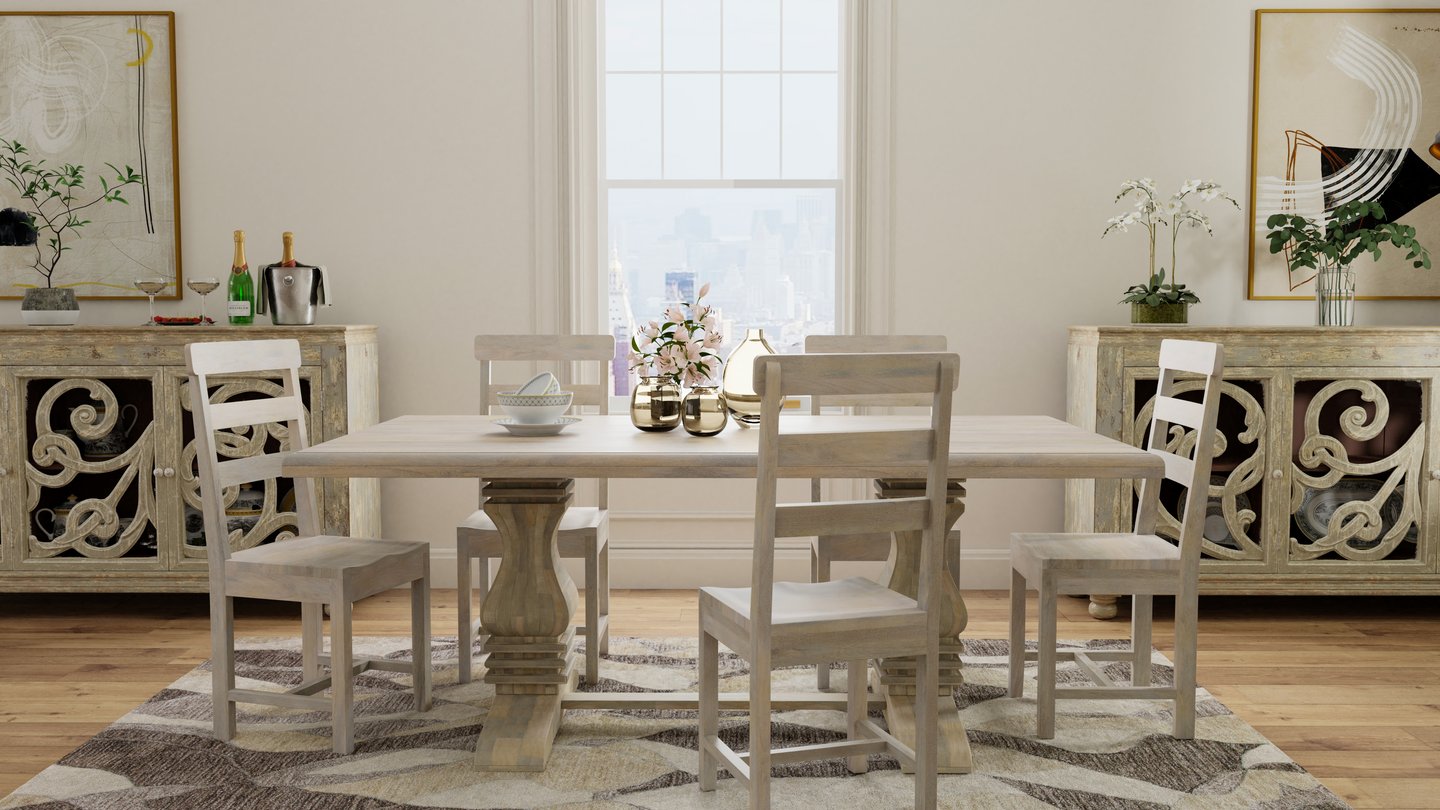
How D2C Brands Can Leverage 3D
Since direct-to-consumer (D2C) brands directly communicate with their customers, creating quality content assets has never been more important. A 3D visualization platform, like imagine.io, can be an affordable and easy alternative to creating the content required for your D2C brand to stand out versus traditional photography.
D2C Brands: Creating A 3D Content Strategy
Every organization needs a content strategy to compete in today’s marketplace. For D2C brands in the home furnishings space, visual content reigns supreme for converting visitors into buyers. Copy and written content is also a necessary part of any content strategy but for the purpose of this discussion, let’s focus on the visual assets that you’ll use to engage your target audience and convert them into customers…
There are many different types of 3D content you can create. The most successful D2C brands take a mixed approach to content strategy, which involves a number of key visual pieces. This includes:
- Lifestyle imagery
- Silhouettes
- Vignettes
- Video
- AR/VR
- Product Configurators
Let’s discuss how each type of 3D content can be used and how it enables D2C brands to go to market faster, sell more, increase customer satisfaction, and generate ongoing brand loyalty.
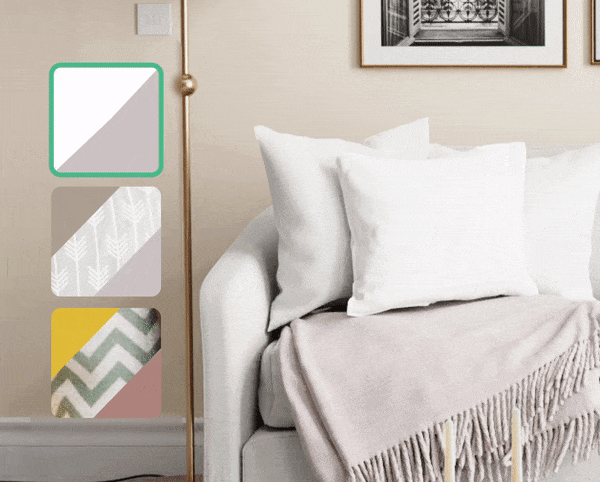

Types of 3D Content for D2C Brands
There are 6 core types of media that can be created when you use imagine.io 3D for your D2C brand. All of these categories have uses and advantages, and we should explore this further:
Lifestyle Imagery
Lifestyle photographs can offer another powerful selling strategy for D2C brands (or any brand, really!). Selling inspirational imagery rather than products alone is a widely used marketing technique. But creating lifestyle imagery for all of your products and collections is expensive and time consuming. If you want to maximize sales, it's important that the consumers understand how the product fits into their daily life, the way it can improve their house, and how they can experience that when the product is purchased. 3D templates like those available in imagine.io makes creating lifestyle imagery quick, simple and affordable for D2C brands. Through highly customizable templates, you can create imagery that reflects your brand and engages your target buyers in minutes instead of months!
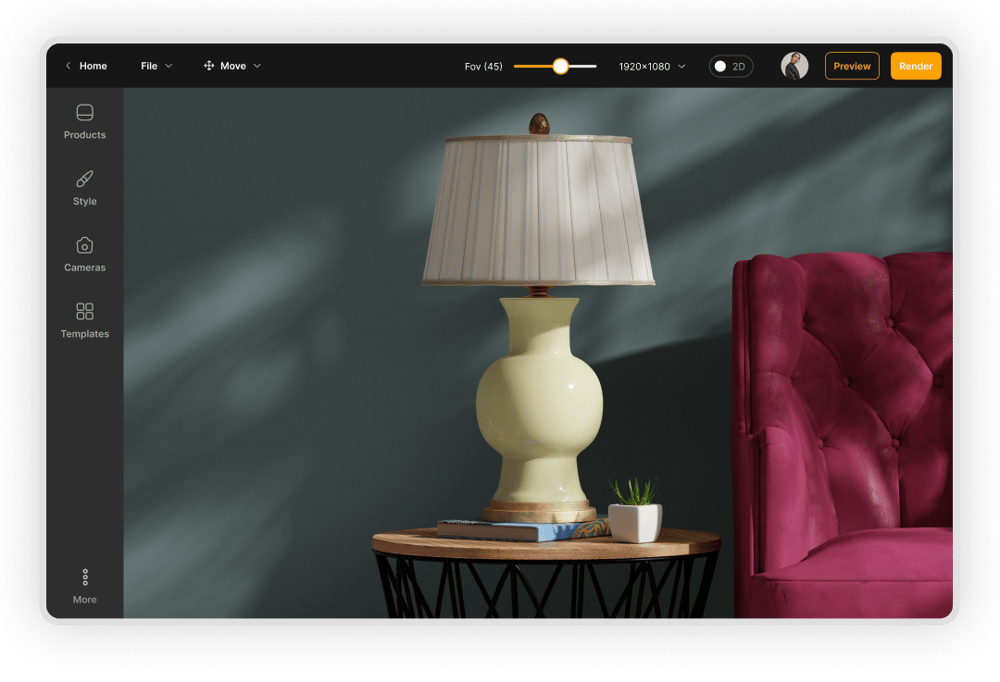
Silhouettes
These kinds of 3D visuals isolate images and create a great sales instrument that focuses more on your product and enables your customers to clearly see them. D2C brands often require silhouettes from multiple angles to quickly showcase all aspects of their products to consumers and are used in tandem with lifestyle imagery to complete the visualization. The time and cost associated with creating silhouettes using studio photography, can be astronomical for a D2C brand, and significantly slow down your speed to market. By utilizing 3D models and the imagine.io content studio, you can ensure you are optimizing your operations successfully.
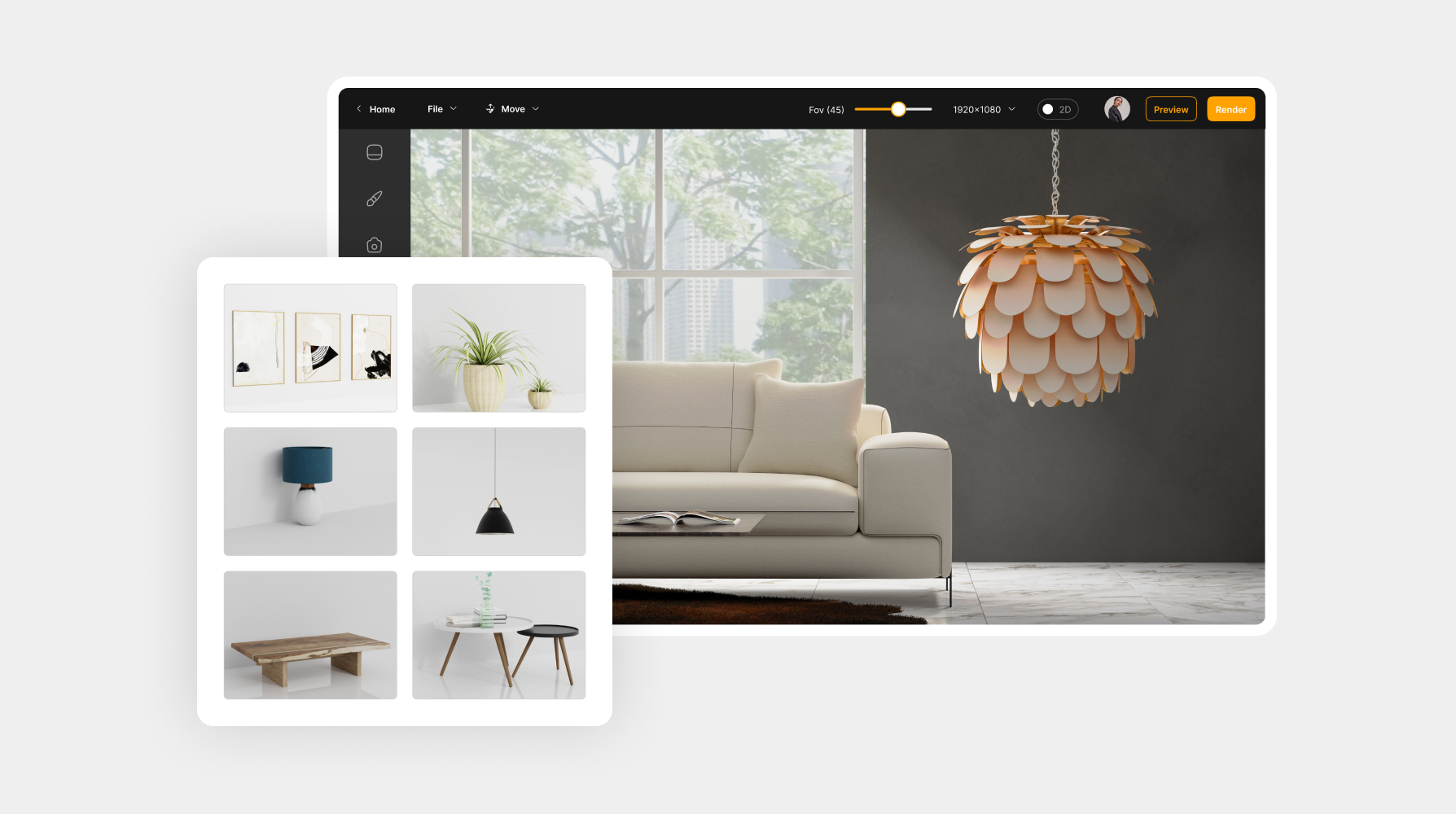
Vignettes
A great advantage of designing a new furniture using 3D is that small details can be clearly highlighted. Typically, the prototypes or drawings that manufacturers produce are not detailed enough. There is no close-up or adding those small details in a prototype. A 3D vignette, however, can show the smallest details because the images are very clear. Customers can quickly see texture, embellishments and other design peculiarities.
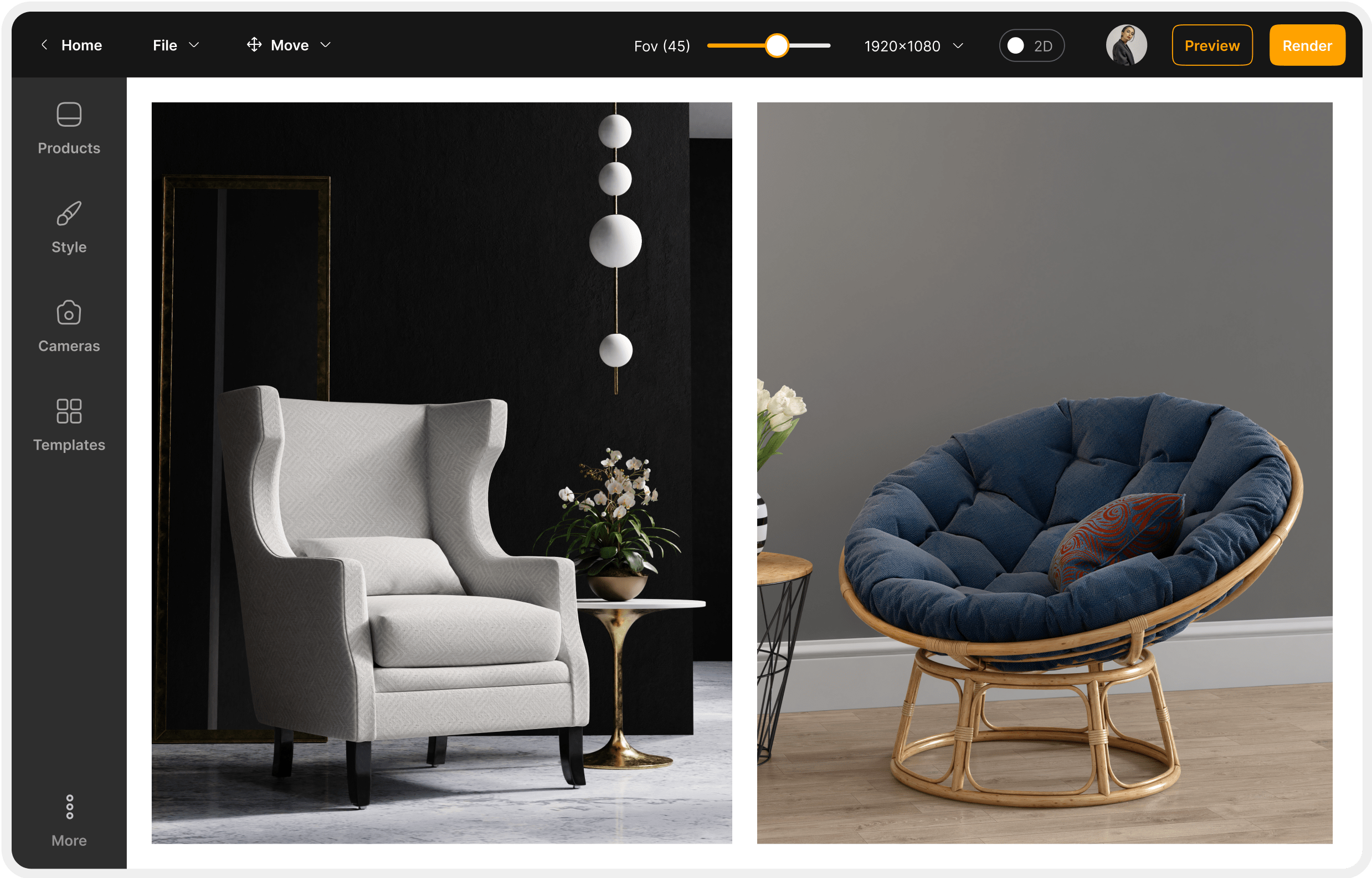
Video
Video should be part of any D2C content strategy. Yet, the cost and time it takes to create even simple video content is enormous through traditional videography. It doesn't have to be nearly as expensive or time consuming to create though. When you release new products or furniture models, you can lever 3D videos as an advertising teaser or product walkthrough. Curiosity can be a major selling feature for any D2C business. You may display just one or more sections of the product, the entire product or the entire teaser video - the options are endless. See the example below for inspiration:
AR/VR
Consumers have become heavily reliant on making their purchasing decisions digitally. As a D2C brand, your digital channels are your storefront. You don’t have brick and mortar options to show customers key details and how your products look and feel in-person. However, by leveraging AR/VR you can simulate interactive shoppable experiences, allowing consumers to see, feel, and imagine how your products work. This ultimately increases buyer confidence, and is an innovative approach to content that many of your competitors may deem too costly or too time-consuming to execute. But with a content platform like imagine.io, you can produce AR/VR experiences quickly, easily, and more cost-effectively than through any third party agency.
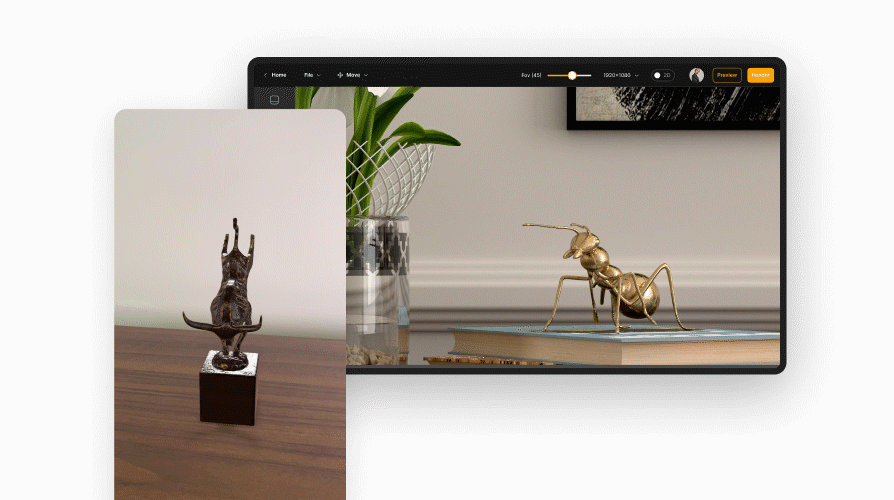
Product Configurators
When you’re selling directly to consumers, it can be hard to convey the overall look and functionality of a product digitally. But it doesn’t have to be. Enter 3D product configurators. Product configurators fill the content gap where 3D imagery and even video may not. By incorporating product configurators into your overall 3D content strategy you empower customers to customize and create versions of the products they want to buy. Since all your models, finishes, and fabrics are in the imagine.io platform, it’s easy to launch a product configurator for any product. You’ll also be able to collect the metadata you need to quickly produce an order.
Product configurators are the most popular feature requested by buyers, and make a dramatic impact on product page views, purchase conversion rates, and on reducing returns.
By incorporating all of these 3D content types into your content strategy, you’ll be able to repurpose assets across the entire buyer journey to create a full-funnel 3D content experience. From the early stages of manufacturing your product, to marketing and advertising, and increasing sales, having a 3D content strategy is paramount to the success of any D2C brand today.
Benefits Of 3D For D2C Brands
We know D2C companies can benefit greatly from 3D content. Improvement in quality of visualizations brings a number of benefits as well as a competitive advantage. To further drive the point home, let’s uncover some of these major benefits and why 3D beats traditional photography every time.
1. Product Design Quality
The process of manufacturing products is a major undertaking, and errors in that process can prove costly and inefficient resulting in wasted money, wasted samples, and wasted time. The option to create furniture prototypes using 3D can drastically reduce errors in product design, ensuring each component is reviewed and manufactured according to specification.
2. Improved Interaction And Customer Experience
The imagine.io curator allows you to see products from a 360 degree angle. You can take product shots from every angle and ensure customers see your product in all aspects. Additionally, through product configuration, you can give customers the option to change colors, fabrics and finishes in realtime and allow them to customize their own products to their liking. This option results in 11x conversions compared to 2D images created using studio photography.
3. Easier Thematic Marketing
Instead of doing different photoshoots at different marketing seasons like Halloween, Easter or Christmas, manufacturers and retailers have a choice of different lifestyle templates for each. It only takes a few hours to create a whole year’s worth of content, enabling you to concentrate on other vital tasks.
4. Cost-Effectiveness
The process of rendering 3D imagery is much more affordable compared to hourly studio photography, videography, or CGI agencies. A 3D content platform like imagine.io provides the perfect solution for D2C brands to create catalogs of products for less money and achieve better results from their imagery. For example, The Great American Home Store was able to increase same-product sales by 46% using 3D imagery on their eCommerce shop.
5. Time-Savings
3D saves a tremendous amount of time for D2C brands to go to market faster and get their products in front of consumers. 3D greatly increases the design-to-production time of a product, cutting out errors and waste, while marketing your product is a breeze in comparison to in-house photography, studio photography or on-location photography, which can take months, even years, to produce.
6. Easier Manufacturing
As we've mentioned, creating 3D models helps avoid costly design errors, reduces waste, and improves sustainability. You can find out if something is wrong before it goes to production, make adjustments before creating a physical sample, and it simplifies and reduces all manufacturing processes. For D2C brands, 3D is a no brainer.
7. Enhancing Visual Communication
Lastly, it helps with marketing and advertising thereby helping you increase your sales and increase your return on investments. You can create stunning advertising campaigns using furniture renderings which will increase preorders dramatically.
3D lifestyle imagery can present furniture collections in the best way possible, allowing you to tell an engaging and successful story that engages your customers.
 What-Is-Rendera_Animate
What-Is-Rendera_Animate
The 3D Content Process
If your D2C brand is interested in creating 3D content there are a few things you should know ahead of time:
-
First, you’ll need to create 3D models: 3D models are produced using sketches, photos, drawings specifications and other CAD designs. In order to maximize and repurpose your products across different content, imagine.io will turn your product into a 3D model. Alternatively, imagine.io can ingest your pre-existing 3D models and import them into the platform for you to use.
-
Preview: With 3D models you can now see your products in varying sizes, finishes, colors, locations, and more, even before they exist. By saving time and money on physical samples D2C brands can create products to exact specifications and gauge market demand before going to production; something unheard of when selling through traditional retailers. Plus, costly design errors can be caught quickly and adjusted to reduce waste.
-
Curate: Once you have your products modeled (20 products take approximately 3 weeks), you can start creating content in imagine.io. By using pre-existing templates, you can produce hundreds of images 90% faster than through traditional photography and/or videography.
- Repurpose: The beauty of 3D is that you can continue to iterate on your products and designs. For instance, perhaps you launched a new fabric or finish for a product, you can upload a .png, .jpg file and add any finish to your 3D model. You can repurpose entire collections based on season or run campaigns.
It's time to stop wasting time and money on traditional photography and start creating 3D content for your D2C brand and start converting visitors into buyers. 






.png?width=500&name=How%20to%20Add%20a%203D%20Product%20Configurator%20to%20Your%20WordPress%20Website%20(Complete%20B2B%20Guide).png)



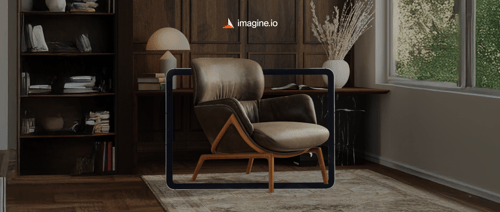
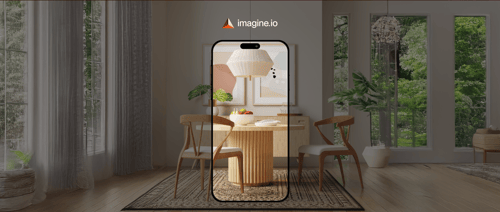











%20(1).png?width=500&name=Why%20Exploded%20Mattress%20Views%20Matter%20(And%20How%20to%20Generate%20Them)%20(1).png)
.png?width=500&name=Best%20Shopify%20Product%20Configurator_%20How%20to%20Choose%20the%20Right%20One%20(2).png)
.png?width=500&name=Why%20Exploded%20Mattress%20Views%20Matter%20(And%20How%20to%20Generate%20Them).png)



.png?width=500&name=Best%20Shopify%20Product%20Configurator_%20How%20to%20Choose%20the%20Right%20One%20(1).png)







.png?width=500&name=How%203D%20Rendering%20Can%20Make%20or%20Break%20Your%20Industrial%20Design%20Pitch%20(1).png)








%20with%20Digital%20Twins%20and%203D%20Visualization.png?width=500&name=Optimizing%20Your%20Digital%20Asset%20Management%20(DAM)%20with%20Digital%20Twins%20and%203D%20Visualization.png)




.png?width=500&name=Styling%20Home%20Decor%20for%202025_%20From%20Global%20Influences%20to%20Playful%20Personalization%20(1).png)
